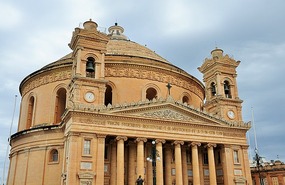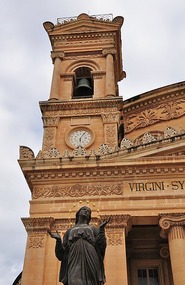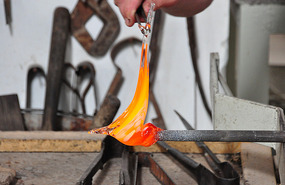I was picked up at 8.00am this morning from the hotel for the Highlights of Malta tour. Given the number of people on the tour (48), it was extremely well organised but very rushed.
It was very, very windy again and the harbour and sea were extremely choppy, God! I hope it calms down tomorrow because I have to get on a ferry for Gozo tomorrow
. I better not eat breakfast.
Our first stop was Mosta to see the Dome; also known as the Rotunda. Mosta Dome (visible from most parts of Malta) has two claims to fame:
a) It's one of the largest domes in the world. and
b) It saw divine intervention when in 1942, the Germans dropped 4 bombs on the church. Three of these didn't explode and one penetrated the dome and landed in the middle of the church. As this was one that didn't explode, none of the 300 people inside the church at that moment were not injured. A miracle, according to the locals. No wonder they love Mary!
A visit to the Ta'Qali Crafts Village and I fell in love with Malta. I got my ceramic door knobs. The glassblowers at this village were much more interesting to watch than those on the island of Munro (Venice). They just seemed more traditional.
Dingle Cliffs are just that, cliffs. Nothing to write home about.
Mdina is a fortified medieval town dating back to the Phoenicians and was once the capital of Malta
. But unlike Middle East medinas, there's no souk as it is not an Arab medina and only the rich live in this walled town. We were told that homes/palaces never appear on the open market - they are passed down (inherited) or sold amongst themselves (ie the existing Mdina inhabitants). You can tell how rich an owner is by the size of their door knocker - the bigger the knocker, the richer the owner. Mdina is also referred to as the Silent City because it is so peaceful. The yellow limestone buildings and the lack of life made the city a bit lifeless and clinical for me. The absolute cleanliness of Mdina added to this 'clinical' feel.
I had a very good lunch in Rabat. Tried a Maltese favourite dish called 'bragiloi' (also known as 'beef olives') - a thin slice of beef wrapped around minced meat and braised in red wine sauce. Yum! I'll have to try and find a maltese cookbook for Meg so she can make these for me.
The last stop of the tour was in Valletta Malta's capital) to view the Malta 5D Show. According to the pamphlet, "Malta 5D is a new generation theatre where you feel the 'real' emotions of the movie. In a short time, you may explore the colourful and impressive episodes of the Maltese history and culture, magnified in 3D film, moving seats, water spray, scents, air blasts and leg tickles. A unique experience for all ages." Well, it was certainly unique; weird is probably a better word to describe it
. It wasn't particularly well done or interesting.
Having experienced this tour and finding it too rushed, I would not do organised tours again in Malta. The hop-on / hop-off bus goes all over the island (Malta) and Gozo (3 different routes), leaving every half hour and is only 17 euros per route per day. Armed with my trusty Lonely Planet Guide, I could have spent longer in the areas I was particularly interested in and then caught the next bus. I have a tour of Gozo tomorrow (organised from Australia) but will use the hop-on / hop-off bus on Thursday when I go to the Hal Saflieni Hypogeum and can then take in other sites that are on the same route.
What I learnt today...
1. The Maltese Islands are made of 5 islands but only 2 are inhabited (Malta and Gozo).
2. Malta has 360 churches, and that doesn't include those on Gozo or the multitude of chapels. How can such a small island fit so many churches on it? Of these 360 churches only 6 or 7 are not dedicated to Mary. They sure love Mary here.
3. The fruit of the prickly pear is a favoured fruit on Malta and they make a liqueur from it. I bought a jar of prickly pear jam.
4. The Maltese language has been influenced by the Phoenicians, Romans, Arabs, Italians, French and English.
5. Mdina and Valletta glass differs from Murano glass in that it is thicker glass, doesn't use silver and gold glitter and focuses on Mediterranean colours.
Highlights of Malta
Tuesday, June 03, 2014
 Sliema, Island of Malta, Malta
Sliema, Island of Malta, Malta
Other Entries
-
16Traveling to Alberobello
May 1717 days prior Alberobello, Italyphoto_camera6videocam 0comment 2
Alberobello, Italyphoto_camera6videocam 0comment 2 -
17Trulli houses
May 1816 days prior Alberobello, Italyphoto_camera8videocam 0comment 1
Alberobello, Italyphoto_camera8videocam 0comment 1 -
18Florence of the south
May 1915 days prior Lecce, Italyphoto_camera11videocam 0comment 0
Lecce, Italyphoto_camera11videocam 0comment 0 -
19Staying in a Sassi
May 2014 days prior Matera, Italyphoto_camera14videocam 0comment 1
Matera, Italyphoto_camera14videocam 0comment 1 -
20It's sassy in Sassi
May 2113 days prior Matera, Italyphoto_camera6videocam 0comment 0
Matera, Italyphoto_camera6videocam 0comment 0 -
21Sicily
May 2212 days prior Taormina, Italyphoto_camera12videocam 0comment 0
Taormina, Italyphoto_camera12videocam 0comment 0 -
22The Greeks in Sicily
May 2311 days prior Taormina, Italyphoto_camera4videocam 0comment 1
Taormina, Italyphoto_camera4videocam 0comment 1 -
23Honouring the Greeks?
May 2410 days prior Syracuse, Italyphoto_camera7videocam 0comment 0
Syracuse, Italyphoto_camera7videocam 0comment 0 -
24Mt Etna unveiled
May 259 days prior Taormina, Italyphoto_camera6videocam 0comment 1
Taormina, Italyphoto_camera6videocam 0comment 1 -
25Ancient Opulance
May 268 days prior Agrigento, Italyphoto_camera8videocam 0comment 0
Agrigento, Italyphoto_camera8videocam 0comment 0 -
26Valley of the Temples
May 277 days prior Agrigento, Italyphoto_camera8videocam 0comment 4
Agrigento, Italyphoto_camera8videocam 0comment 4 -
27No door knobs
May 286 days prior Marsala, Italyphoto_camera3videocam 0comment 0
Marsala, Italyphoto_camera3videocam 0comment 0 -
28Up in the clouds
May 295 days prior Marsala, Italyphoto_camera14videocam 0comment 0
Marsala, Italyphoto_camera14videocam 0comment 0 -
29Cruising the Mediterranean
May 304 days prior Marsala, Italyphoto_camera7videocam 0comment 0
Marsala, Italyphoto_camera7videocam 0comment 0 -
30Ugly city with fantastic mosaics
May 313 days prior Palermo, Italyphoto_camera16videocam 0comment 1
Palermo, Italyphoto_camera16videocam 0comment 1 -
31Cefalu
Jun 012 days prior Palermo, Italyphoto_camera6videocam 0comment 0
Palermo, Italyphoto_camera6videocam 0comment 0 -
32On the move again
Jun 021 day prior Sliema, Maltaphoto_camera0videocam 0comment 2
Sliema, Maltaphoto_camera0videocam 0comment 2 -
33Highlights of Malta
Jun 03 Sliema, Maltaphoto_camera8videocam 0comment 1
Sliema, Maltaphoto_camera8videocam 0comment 1 -
34Island of Gozo
Jun 041 day later Sliema, Maltaphoto_camera10videocam 0comment 0
Sliema, Maltaphoto_camera10videocam 0comment 0 -
35A reason to visit Malta
Jun 052 days later Sliema, Maltaphoto_camera9videocam 0comment 0
Sliema, Maltaphoto_camera9videocam 0comment 0 -
36Better see Valletta!
Jun 063 days later Sliema, Maltaphoto_camera8videocam 0comment 0
Sliema, Maltaphoto_camera8videocam 0comment 0 -
37Coming home
Jun 074 days later Larnaca, Cyprusphoto_camera0videocam 0comment 0
Larnaca, Cyprusphoto_camera0videocam 0comment 0 -
38Run, run, run!
Jun 085 days later Dubai, United Arab Emiratesphoto_camera0videocam 0comment 0
Dubai, United Arab Emiratesphoto_camera0videocam 0comment 0 -
39Home country
Jun 085 days later Sydney, Australiaphoto_camera0videocam 0comment 0
Sydney, Australiaphoto_camera0videocam 0comment 0 -
40Home Sweet Home
Jun 096 days later Albury, Australiaphoto_camera0videocam 0comment 2
Albury, Australiaphoto_camera0videocam 0comment 2
Comments
2025-05-22
Comment code: Ask author if the code is blank

 Sliema, Island of Malta, Malta
Sliema, Island of Malta, Malta












pip
2014-06-04
the number of churches in Sicily and Malta seem to worry/surprise you. In Malta it should be remembered they were home to crusaders and hospitaliers. I probably would feel the same way about Mary, if I was in the church and the bomb didn't go off.